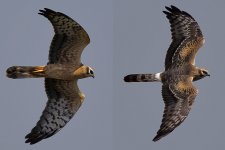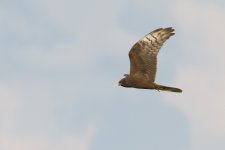Tib78
Well-known member
Not sure whether or not this is the right place to post this. But here we go.
This oiled harrier: http://birdingfrontiers.com/2011/10/13/juvenile-pallid-harrier-identification/ has prompted an interesting discussion on Birding frontiers, with the great input of JanJ.
Further discussion on this bird here: http://birdingfrontiers.com/2011/10/19/identification-update-pallid-harrier/
First of all: Has this bird been accepted/rejected by the British RC (and why)? or is the record acceptance still pending?
One thing that surprises me is that seemingly no one has suggested the possibility of a (pure) juvenile Montagu's. The debate on the wing formula minutiae is certainly interesting and enlightening but if we step back for a second and look at the whole bird...well, I feel montagu's should be considered a very serious option in this case.
***Edit: Actually I see Montagu's has been suggested more than once in the comments. Especially by Lars Svensson himself. That makes me feel a little bit better, at least i won't look like a total idiot if the bird is identified as something else!***
To my eyes the structure/jizz of this bird looks perfect for Montagu's. For example, if the only picture available were photo h : http://birdingfrontiers.com/2011/10/13/juvenile-pallid-harrier-identification/img_5951a/ I would have said juv Montagu's straight away (which is a bit worrying...) because of the long tail, massive wings (long hand) and very slim body. But of course juv Pallid and Montagu's are quite close in terms of structure, and relying on jizz from still pictures is not advisable.
The problem with the oiling is that it does not a allow a precise and confident assessment of the plumage characteristics. The head pattern especially seems to vary from an image to another, yet at no point it seems to favour Pallid to my eyes: the collar looks thin and very rufous (concolorous with the underparts) and does not stand out very well. Some images show a lot of white around the eye, but again it seems to vary. The colour of the underparts is rather intense too, but I guess it could be imputable to the fulmar oil.
Now if we come back to the wing formula and especially the emargination of P9. It is established that the emargination of P9 is hidden by the primary coverts on Pallid (and Hen) while it is situated further up the feather on Montagu's and is therefore visible.
On the Shetland bird, the emargination of P9 seems concealed, however owing to the combination of: 1)foreshortening angle (the wing is not held at a 90° angle), 2)state of the feathers and 3) lack of crystal clear definition I am not sure the emargination would be visible. I attached a picture of a young female Montagu's by Stephen Daly. On this image, the P9 emargination is far from obvious to me, it may be because of the inner web of P10 overlapping with the outer web of P9. I originally found the picture on the surfbirds gallery: http://www.surfbirds.com/gallery/search2.php?species=Montagu's Harrier
Continuing with the wing formula, like Jan I am seeing a notch on the inner web of P7. But I would interpret it differently: the notch looks shallow to me, which is perfect for Montagu's.
The underwing pattern is largely accepted as one the crucial feature to look at when identifying juv pygmac harriers. Again I am going against the finder's opinion here, but the primary pattern looks better fon Monty's to me: the trailing of the inner hand looks as dark as the primary barring and the fingers are largely dark.
As far as I know, the primary barring could fit either species.
So I would be pleased to read more comments on this bird (comments from the BBRC would be especially welcome, if any).
This oiled harrier: http://birdingfrontiers.com/2011/10/13/juvenile-pallid-harrier-identification/ has prompted an interesting discussion on Birding frontiers, with the great input of JanJ.
Further discussion on this bird here: http://birdingfrontiers.com/2011/10/19/identification-update-pallid-harrier/
First of all: Has this bird been accepted/rejected by the British RC (and why)? or is the record acceptance still pending?
One thing that surprises me is that seemingly no one has suggested the possibility of a (pure) juvenile Montagu's. The debate on the wing formula minutiae is certainly interesting and enlightening but if we step back for a second and look at the whole bird...well, I feel montagu's should be considered a very serious option in this case.
***Edit: Actually I see Montagu's has been suggested more than once in the comments. Especially by Lars Svensson himself. That makes me feel a little bit better, at least i won't look like a total idiot if the bird is identified as something else!***
To my eyes the structure/jizz of this bird looks perfect for Montagu's. For example, if the only picture available were photo h : http://birdingfrontiers.com/2011/10/13/juvenile-pallid-harrier-identification/img_5951a/ I would have said juv Montagu's straight away (which is a bit worrying...) because of the long tail, massive wings (long hand) and very slim body. But of course juv Pallid and Montagu's are quite close in terms of structure, and relying on jizz from still pictures is not advisable.
The problem with the oiling is that it does not a allow a precise and confident assessment of the plumage characteristics. The head pattern especially seems to vary from an image to another, yet at no point it seems to favour Pallid to my eyes: the collar looks thin and very rufous (concolorous with the underparts) and does not stand out very well. Some images show a lot of white around the eye, but again it seems to vary. The colour of the underparts is rather intense too, but I guess it could be imputable to the fulmar oil.
Now if we come back to the wing formula and especially the emargination of P9. It is established that the emargination of P9 is hidden by the primary coverts on Pallid (and Hen) while it is situated further up the feather on Montagu's and is therefore visible.
On the Shetland bird, the emargination of P9 seems concealed, however owing to the combination of: 1)foreshortening angle (the wing is not held at a 90° angle), 2)state of the feathers and 3) lack of crystal clear definition I am not sure the emargination would be visible. I attached a picture of a young female Montagu's by Stephen Daly. On this image, the P9 emargination is far from obvious to me, it may be because of the inner web of P10 overlapping with the outer web of P9. I originally found the picture on the surfbirds gallery: http://www.surfbirds.com/gallery/search2.php?species=Montagu's Harrier
Continuing with the wing formula, like Jan I am seeing a notch on the inner web of P7. But I would interpret it differently: the notch looks shallow to me, which is perfect for Montagu's.
The underwing pattern is largely accepted as one the crucial feature to look at when identifying juv pygmac harriers. Again I am going against the finder's opinion here, but the primary pattern looks better fon Monty's to me: the trailing of the inner hand looks as dark as the primary barring and the fingers are largely dark.
As far as I know, the primary barring could fit either species.
So I would be pleased to read more comments on this bird (comments from the BBRC would be especially welcome, if any).
Attachments
Last edited:






